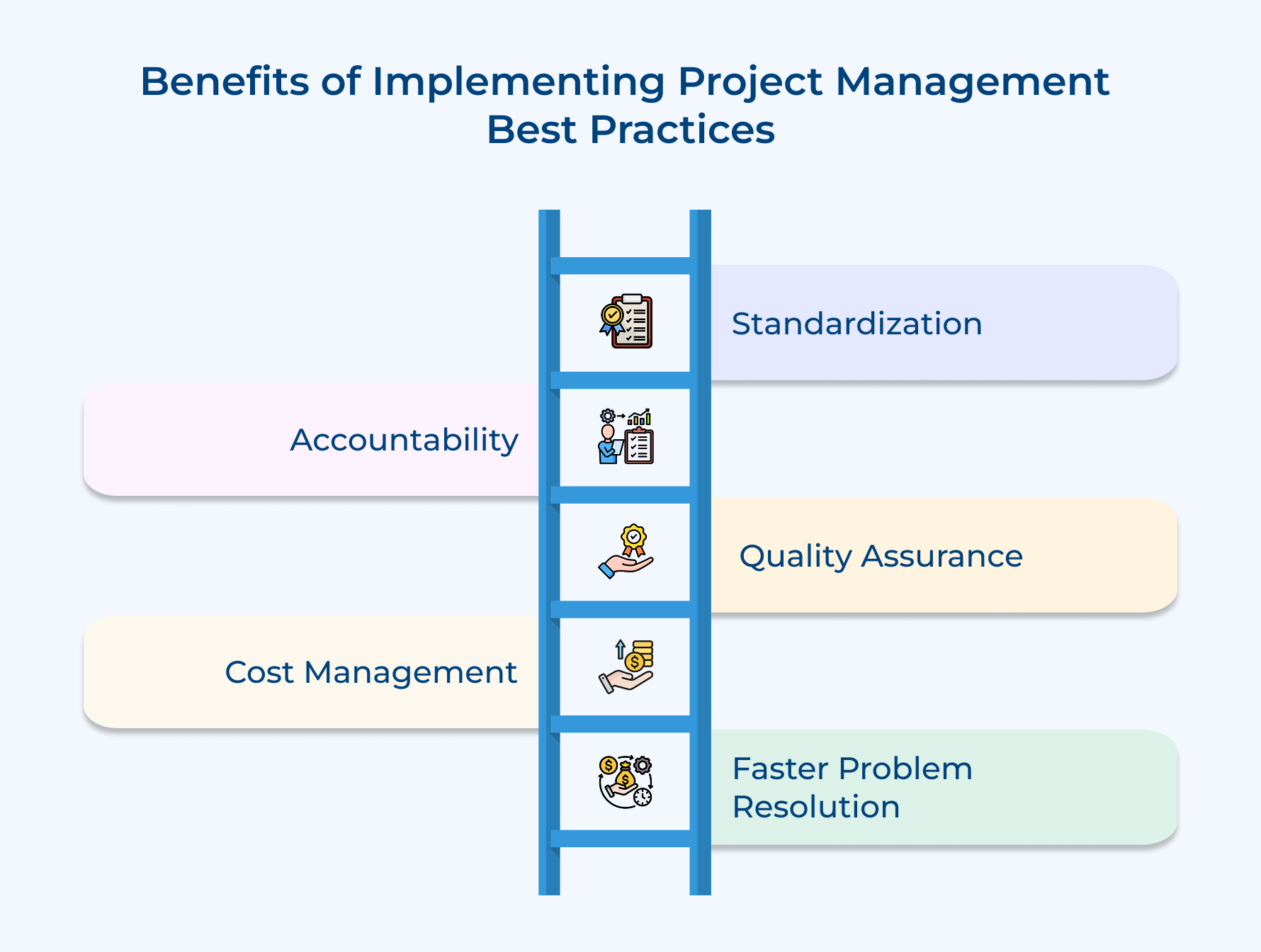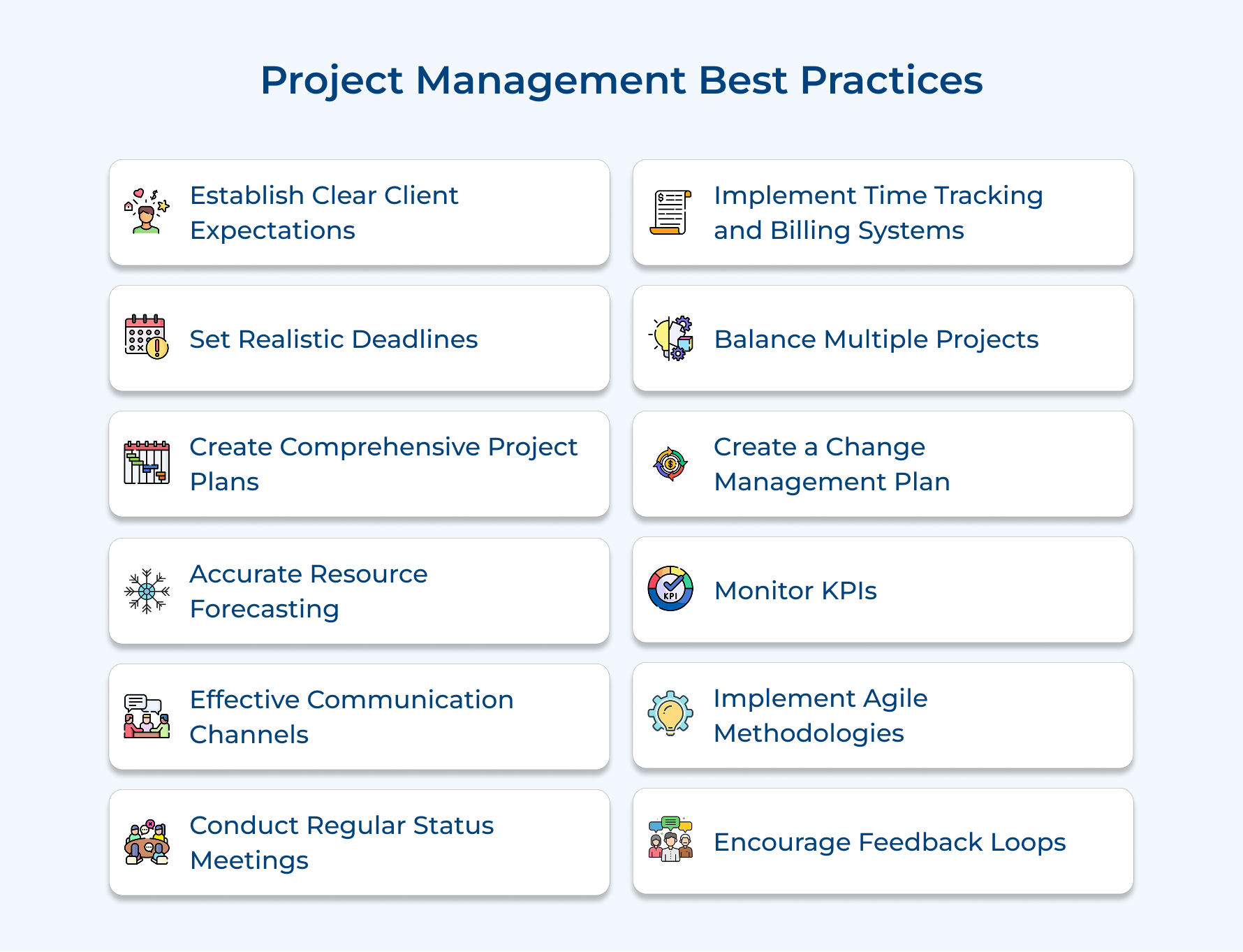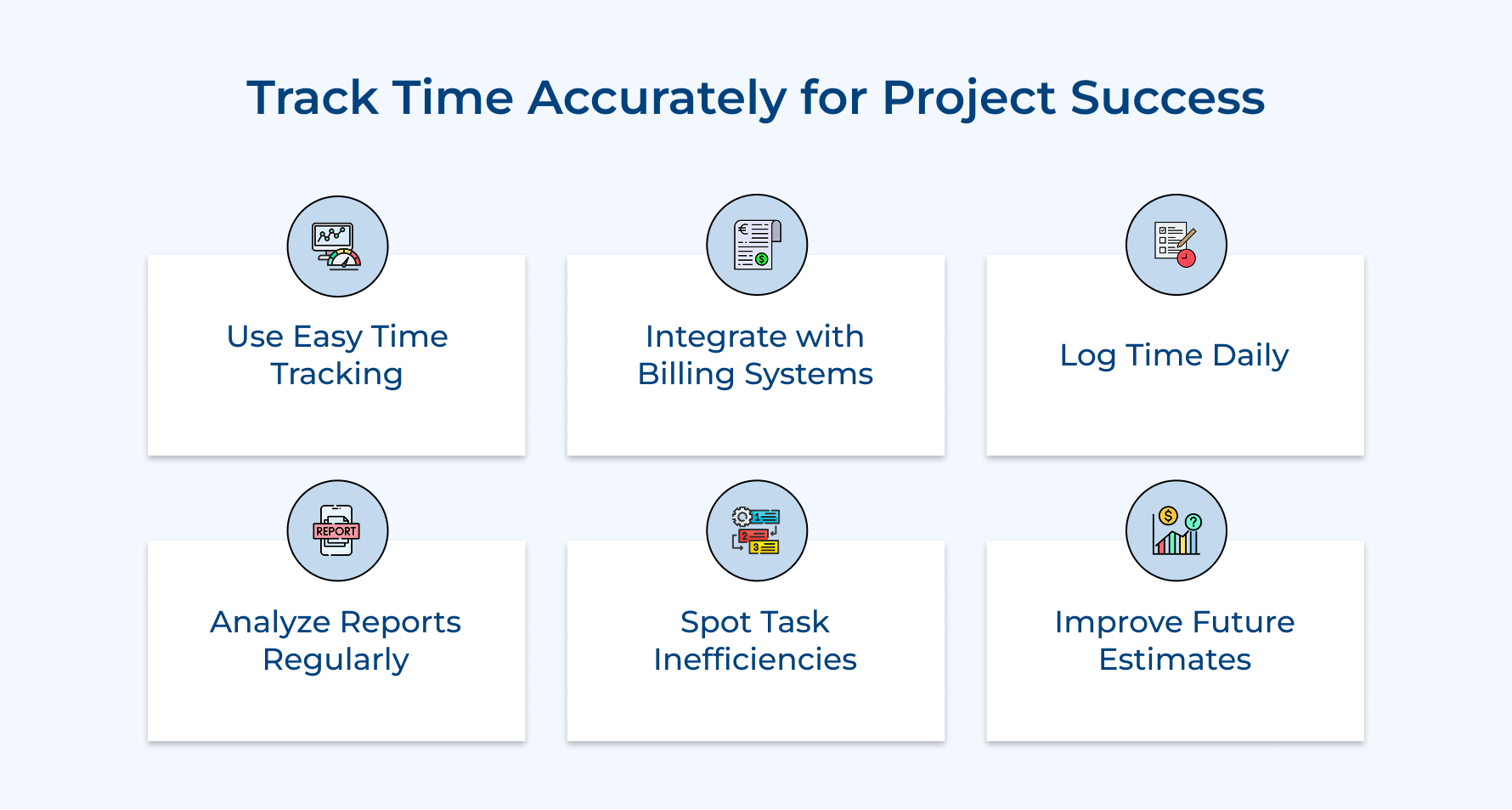Project Management Best Practices for Business Success

Key Highlights
Keeping clients happy, delivering consistent results, and staying within budget are no easy feats. With so much on the line, missing deadlines or going over budget doesn’t just affect a project—it can damage client trust, impacting your agency’s reputation.
But here’s the good news!
With the right project management practices, those common hurdles can be transformed into stepping stones for success. Implementing tried-and-true strategies helps agencies streamline workflows, improve communication, as well as maximize the use of available resources..
We’ll dive into essential project management best practices tailored for agencies. Regardless of whether you’re looking to refine your processes or just keep projects on track, these tips will set you up for success and help strengthen client relationships.
Why Implementing Best Practices is Crucial for Project Success?
Implementing best practices ensures project success, enhancing efficiency, and driving client satisfaction. Here are the reasons why:
Standardization: Standardizing processes enhances consistency in project execution. Agencies benefit by building client trust, streamlining workflows, as well as ensuring that teams deliver predictable outcomes across various initiatives.
Accountability: A clear definition of roles and responsibilities encourages ownership among members, enhancing collaboration while driving successful project outcomes. Agencies see improved performance as individuals strive to meet their commitments.
Quality assurance: Consistent adherence to high standards not only elevates deliverables but also enhances client satisfaction. Hence, reinforcing the agency’s reputation and increasing the likelihood of repeat business.
Cost management: Effective management of project budgets is achieved through best practices. Firms can minimize overspending while maximizing returns on investment, ensuring financial sustainability and competitiveness through disciplined resource allocation.
Faster problem resolution: Quicker identification and resolution of issues result from established methodologies. Professional services benefit from minimized disruptions, allowing teams to maintain momentum and meet deadlines while ensuring that client expectations are consistently met.
12 Best Practices for Successful Project Management
Utilizing best practices can significantly improve project outcomes, streamline processes, and build team collaboration. Here are the key practices to adopt.
1. Establish clear client expectations and deliverables
Let’s be real. Nothing derails a project faster than misaligned expectations. Getting clear on what’s expected—as well as by when—prevents misunderstandings, scope creep, and, ultimately, unhappy clients.
Start with a detailed project charter or statement of work that lays out all key deliverables, timelines, and criteria for success. Host a meeting to confirm everything with the client and revisit this document regularly to stay aligned as the project progresses.
Use the SMART criteria (Specific, Measurable, Achievable, Relevant, Time-bound) to define deliverables that are rock solid. Add in visuals, like flowcharts or mockups, to clarify complex deliverables. Set up a formal change request process to handle evolving expectations without derailing the project.
2. Set Realistic Deadlines
Deadlines can make or break a project. Overly ambitious ones can lead to rushed work, burnout, and a dip in quality—none of which makes clients happy. On the flip side, realistic deadlines allow for proper planning, effective risk management, and a built-in buffer for any surprise hiccups.
Break the project into smaller tasks and estimate the time needed for each one. Don’t forget to account for team capacity, dependencies, and potential risks.
How else can you improve your project management, you ask?
- Techniques like PERT (Program Evaluation and Review Technique) can help you make more accurate time estimates.
- Get the team involved in setting deadlines for buy-in and leverage their expertise.
- Use time-tracking tools to improve future estimates based on actual data from past projects.
Also keeping communication open with stakeholders means they’ll always know about any timeline shifts.
3. Create Comprehensive Project Plans
A well-rounded project plan provides direction and keeps everyone on track. The plan doesn’t just help you identify risks early but allocate resources effectively and manage dependencies.
Develop a detailed plan that covers scope, timeline, budget and resources, along with communication strategies. Tools like project management software can help you build Gantt charts, work breakdown structures, and resource allocation plans. Keep the plan updated and make sure the team as well as stakeholders have access to the parts they need.
Here’s what you can do to stand out from the competition,
- Use a standard template for consistency and to save time across projects.
- Build contingency plans for high-priority risks so you’re prepared.
- Consider adding a high-level summary for quick reference, especially for execs or busy clients.
4. Accurate Resource Forecasting
Imagine going on a road trip without knowing if you have enough fuel, snacks, or a reliable map. Project planning without accurate resource forecasting is pretty much the same.
When you forecast resources correctly, you’re not just ensuring that the right talent is on hand when you need it—you’re optimizing productivity, preventing bottlenecks, and keeping the project on budget.
Resource management software can be a game-changer here, helping you track allocations and adjust forecasts as you go. Remember to factor in both internal and external resources so you’re covered no matter what comes up.
Create a thorough resource plan that outlines the skills, roles, and time commitments for every stage of the project. A skills matrix is a handy tool for quickly matching team members to tasks. Scenario planning helps you be ready for changes in resource demands. Regular feedback from the team can reveal where forecasts might need tweaking.
5. Have Effective Communication Channels
Let’s talk about talking. Communication is the glue that holds a project together. Without clear channels, misunderstandings crop up, tasks fall through the cracks, and delays creep in. A RACI matrix (Responsible, Accountable, Consulted, Informed) makes roles and responsibilities crystal clear.
Set up a communication plan that covers the what, when, and how of project updates. Mix it up with tools like email, instant messaging, and video calls to keep everyone in the loop. Regular check-ins are crucial, as is a central hub for all project documents, so nothing is lost in the shuffle. Tailor your communication style to what works best for your stakeholders and team.
6. Conduct Regular Status Meetings
Meetings—some love them, some dread them, but when it comes to project management, regular status meetings are essential. The team gets to check in, flag any obstacles, and ensure the project’s still on track.
Status meetings boost accountability, invite collaboration, and keep everyone focused on shared goals.
Make these meetings worthwhile by setting a standard agenda and timeboxing each topic. Use this time to review progress, address risks, as well as agree on the next steps. Be sure to document the key points and follow up with action items.
Here are some best tips you can follow,
- Stick to an agenda, and keep discussions efficient with time limits for each topic.
- Rotate facilitators to keep things fresh and encourage team engagement.
- Visual aids like burndown charts or Kanban boards can make progress reviews easy to digest.
7. Implement robust time tracking and billing systems
Time tracking might not be the most glamorous part of project management, but they’re essential for accurate project costing and billing clients fairly. They provide real-time data that keeps everything on track while giving you a way to spot inefficiencies and optimize as you go.
Invest in a user-friendly time-tracking tool that integrates with your project management and billing systems. This way, team members can easily log their time daily, making billing accurate and consistent. Set up reports for regular analysis, so you’ll have data ready to help improve future estimates and resource allocation.
Let’s understand this with an example. Say you’re managing a digital marketing campaign for a client. A robust time tracking in place ensures that you notice that SEO tasks are consistently taking longer than planned.
With that insight, you might decide to allocate more time to SEO in future campaigns, adjust deadlines, or bring on an additional team member. The result? Your next project is not only more accurate but also more profitable.
8. Balance Multiple Projects and Clients Effectively
Balancing several projects at once? It’s like juggling. Managing multiple clients and projects is all about strategy. A well-balanced workload keeps resources fully utilized, opens doors for skill development, and lets you cross-pollinate ideas across projects.
To make it happen, adopt a portfolio management approach. Here is the list of steps to consider.
- Start by prioritizing projects based on their strategic value, resource demands, and deadlines.
- Use resource management tools to assign team members based on their availability and skill sets.
- To avoid burnout, set clear boundaries as well as time blocks so everyone can stay focused on each project.
9. Create a Change Management Plan
Imagine you’re leading a web development project and mid-project, the client decides they want to add an e-commerce feature. Without a change management plan, this could throw off your timeline and budget.
But with a plan, you can evaluate the impact of adding this feature, get approvals, and update the team so that everyone’s on board with the new scope as well as the timeline.
How can you effectively implement this?
- Establish a formal change request process, complete with templates for requests and impact assessments.
- Set up a change control board to evaluate each change’s impact on timelines, budgets, and resources.
- Keep everyone in the loop by documenting changes and updating project plans accordingly.
10. Monitor Key Performance Indicators (KPIs)
KPIs give you critical insight into how smoothly your project is running and flag any issues before they become problems. By tracking relevant KPIs, you make data-driven decisions, align the team’s efforts, and keep stakeholders informed.
To get started, select KPIs that reflect your project’s goals, like on-time delivery, budget variance, or customer satisfaction. Use reporting tools that track these metrics visually so you can spot trends and forecast outcomes. Regularly review KPIs with the team and stakeholders, using them to guide adjustments.
Pro tips:
- Limit KPIs to the essentials so the team remains focused on what matters most.
- A balanced scorecard approach can ensure you cover multiple project dimensions.
- Engage the team in setting and tracking KPIs for added ownership.
11. Implement agile methodologies for flexibility
Let’s say you’re running a software development project. The client wants an e-commerce function added halfway through.
Agile methodology lets you pause, add this requirement to the backlog, and adjust the next sprint to start building it out. Hence, keeping everyone in sync and avoiding costly last-minute changes.
Consider starting with frameworks like Scrum or Kanban. Break down your project into short sprints, or set work-in-progress limits to maintain focus. Daily stand-ups, sprint planning, and retrospectives keep the team aligned as well as improve workflow.
For managing tasks, user stories as well as a product backlog are essential, as is building a culture where the team takes charge of their tasks and is open to regular client input.
12. Encourage Feedback Loops
When it comes to project management, feedback loops open up communication, boost collaboration, and lead to a culture of continuous improvement.
Schedule regular check-ins with team members and stakeholders. It can be done via surveys, one-on-ones, or retrospectives, where you gather input, act on it and share the actions taken.
Even setting up an anonymous feedback channel can be useful for sensitive issues. Keep the loop alive by integrating feedback into project processes and planning.
Here’s how you can keep the feedback loops active,
- Create a safe space where everyone feels comfortable sharing feedback.
- Structure feedback sessions with “Start, Stop, Continue” to focus on actions.
- Celebrate wins to keep the team motivated and treat constructive feedback as growth opportunities.
Elevating Outcomes Through Project Management Best Practices
Implementing solid project management best practices is essential for consistently delivering quality results on time. These strategies boost efficiency and make the most of resources, which naturally leads to more profitable projects. When team members communicate clearly and work collaboratively, everyone stays aligned with client expectations—helping build trust as well as encouraging repeat business.
Prioritizing quality not only strengthens client relationships but also sets the stage for future growth. By adopting these practices, teams create a proactive, solution-oriented environment that’s well-prepared to tackle challenges, consistently delivering high-quality outcomes. The approach doesn’t just keep projects on track; it drives long-term success and sustainability.
Limit time — not creativity
Everything you need for customer support, marketing & sales.
Neeti Singh is a passionate content writer at Kooper, where he transforms complex concepts into clear, engaging and actionable content. With a keen eye for detail and a love for technology, Tushar Joshi crafts blog posts, guides and articles that help readers navigate the fast-evolving world of software solutions.


